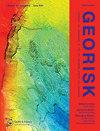A case study of resistance factors for bearing capacity of shallow foundations using plate load test data in Korea
IF 4.8
3区 工程技术
Q1 ENGINEERING, GEOLOGICAL
Georisk-Assessment and Management of Risk for Engineered Systems and Geohazards
Pub Date : 2022-12-15
DOI:10.1080/17499518.2022.2149814
引用次数: 1
Abstract
ABSTRACT Ground conditions comprised of slightly or completely weathered rock are frequently encountered in design of bridge foundations in Korea. It is rather challenging to assess the accuracy of the common design methodologies for shallow foundations in these ground conditions as the foundation bearing capacity depends on the degree of weathering. This paper presents reliability-based derivation of resistance factors for the bearing capacity of shallow foundations on slightly and completely weathered rock using field plate load test data. More than 140 plate load tests were performed at 52 sites, 33 of which were considered to be of high quality and reliable. These high-quality tests were used to evaluate the uncertainties associated with the bearing capacity equations, and the resistance factors corresponding to current prescribed load factors. A reliability-based approach, with target annual failure probabilities of 1.0 × 10−3, 2.0 × 10−4, 1.0 × 10−4, was adopted to estimate the required resistance factors for different design equations. A Bayesian approach was adopted to facilitate quantification and propagation of statistical parameter uncertainty due to limited available data. The best estimates of the calibrated resistance factors range from 0.40 to about 0.47 for the considered target reliability levels, which is in good agreement with currently used values in Korea.利用韩国板载试验数据对浅基础承载力阻力因素的实证研究
在韩国的桥梁基础设计中,经常遇到由轻微或完全风化的岩石组成的地基条件。在这些地基条件下,由于地基承载力取决于风化程度,评估浅层基础常用设计方法的准确性是相当具有挑战性的。本文利用现场板载试验数据,提出了基于可靠度的微风化和完全风化岩石浅基础承载力阻力系数推导方法。在52个地点进行了140多次板载试验,其中33个被认为是高质量和可靠的。这些高质量的试验被用来评估与承载力方程相关的不确定性,以及与当前规定荷载因子对应的阻力因子。采用基于可靠性的方法,以年失效概率为1.0 × 10−3、2.0 × 10−4和1.0 × 10−4为目标,估计不同设计方程所需的阻力因子。由于可用数据有限,采用贝叶斯方法便于统计参数不确定性的量化和传播。对于考虑的目标可靠性水平,校准电阻因子的最佳估计值范围为0.40至约0.47,这与韩国目前使用的值非常一致。
本文章由计算机程序翻译,如有差异,请以英文原文为准。
求助全文
约1分钟内获得全文
求助全文
来源期刊
CiteScore
8.70
自引率
10.40%
发文量
31
期刊介绍:
Georisk covers many diversified but interlinked areas of active research and practice, such as geohazards (earthquakes, landslides, avalanches, rockfalls, tsunamis, etc.), safety of engineered systems (dams, buildings, offshore structures, lifelines, etc.), environmental risk, seismic risk, reliability-based design and code calibration, geostatistics, decision analyses, structural reliability, maintenance and life cycle performance, risk and vulnerability, hazard mapping, loss assessment (economic, social, environmental, etc.), GIS databases, remote sensing, and many other related disciplines. The underlying theme is that uncertainties associated with geomaterials (soils, rocks), geologic processes, and possible subsequent treatments, are usually large and complex and these uncertainties play an indispensable role in the risk assessment and management of engineered and natural systems. Significant theoretical and practical challenges remain on quantifying these uncertainties and developing defensible risk management methodologies that are acceptable to decision makers and stakeholders. Many opportunities to leverage on the rapid advancement in Bayesian analysis, machine learning, artificial intelligence, and other data-driven methods also exist, which can greatly enhance our decision-making abilities. The basic goal of this international peer-reviewed journal is to provide a multi-disciplinary scientific forum for cross fertilization of ideas between interested parties working on various aspects of georisk to advance the state-of-the-art and the state-of-the-practice.

 求助内容:
求助内容: 应助结果提醒方式:
应助结果提醒方式:


